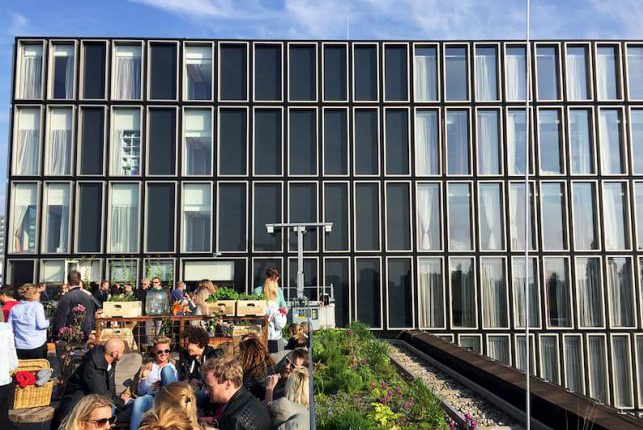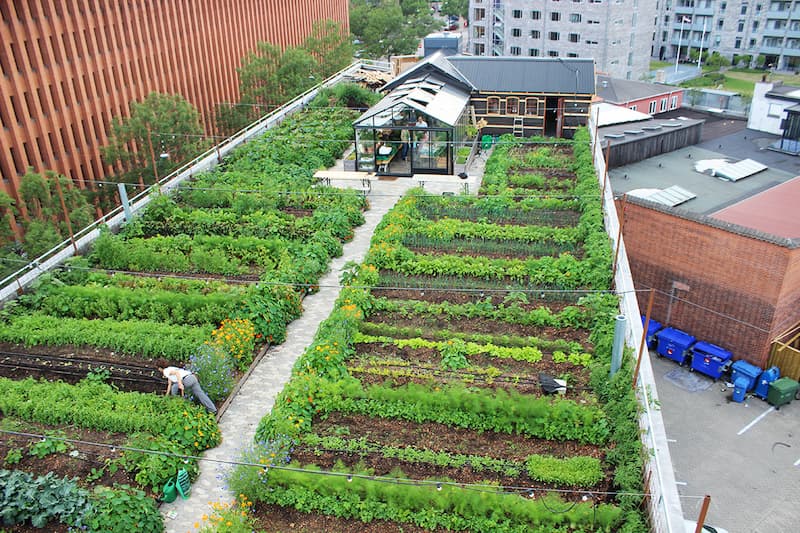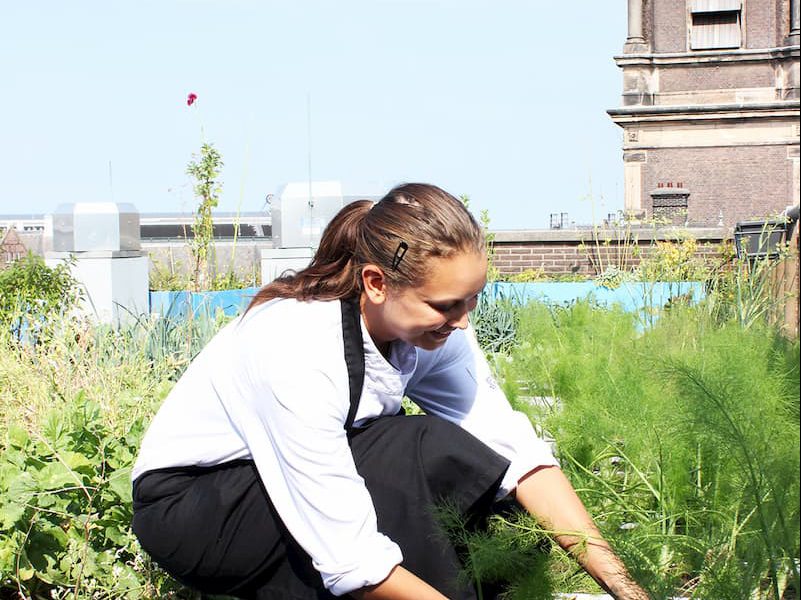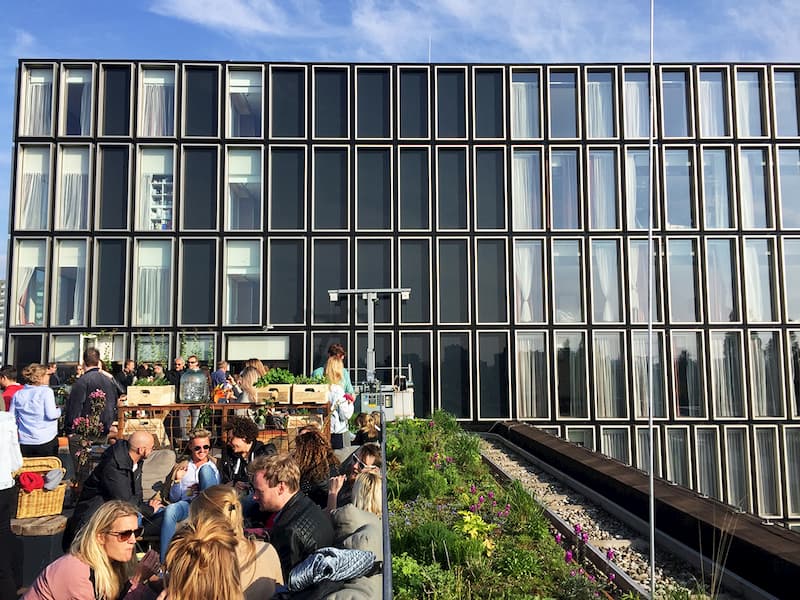

26 Sep Nature Inclusive Design from a Business Angle
by Kelai Diebel
Think about it, how hot do you suppose your roof is? Or, how many liters of perfectly good water do you think run off your roof down into the sewer system? Better yet, does your roof offer an attractive view of the city? The chances are high that your roof is costing valuable space and resources while not tapping into full environmental and economic opportunity.
When we start treating our roofs as the ‘fifth facade,’ and we turn them into lush gardens with attractive functions, we can improve insulation, slow down stormwater runoff, and extend the life of the underlying roof… all while opening up business opportunities as real estate value is added.
The grey alternative is cheaper upfront but how can we really measure the value of all of this return? Climate amelioration, energy savings, better views, green jobs, added real estate value, and a connection to nature are all factors in the pay-off model.
When it comes to biophilic building, hundreds types of buildings, beneficiaries, stakeholders, and technical systems tend to make it hard to see how nature inclusive design can add value to certain business models. If you want to know more about how nature inclusive design can invite a steady revenue stream in your building, read on!
ONE ROOF AT A TIME
Structure, access, location, orientation to the sun, and climate are all critical factors to consider before turning your rooftop to a sustainable business angle. The truth is, not all locations are suited for nature inclusive design and there is no such thing as a one-size-fits-all approach.
-
- Of the three main green roof types, extensive green roofs are thin, lightweight and the least-expensive in construction, however these come with less green impact and typically no-access for users.
- Semi- intensive roof gardens can be planted with biodiverse wildflowers and grasses and can be combined with accessible terrace areas.
- At the other end of the spectrum, once roofs are planted with trees, shrubs and everything in between, our fifth facades become parks thriving with life for both people and nature!
EDIBLE ROOF OPPORTUNITY
On specifically designed roofs, there is an opportunity for urban farming to grow local and nutritious calories for the surrounding area. Depending on the size, structure, and amount of produce, these ‘edible’ roofs can sell produce to local restaurants and markets, or supplement the diets of building occupants.
In all cases, the perks of growing food on roofs are widespread. Built as intensive roof gardens, rooftop farms deliver heightened environmental benefits, like energy savings, stormwater management and habitats for biodiversity. As high-tech greenhouses, these year-round production facilities save water and support reliable and predictable food security. With greater climate control, inorganic fertilization and pesticides can be ruled out. All in all, local and hyper-fresh produce can be provided without transportation, packaging and refrigeration.
ADDED REAL ESTATE AND REVENUE MODELS
There is no doubt that incorporating plants within buildings adds value for both users and the property. Biophilia, the human tendency to seek connections with nature, is magnified in cities where opportunities for connections to nature are limited. That’s why when given the choice to visit a grey or a green venue, most people will choose the green space. In other words, environmental attractiveness stimulates economic activity.
Roof gardens often work with traditional market parties like clients and investors, and so it may be expected that rooftop projects have traditional revenue models. Green roofs however, are not like other products that simply fall into these categories. Modeled around eco-innovation, green roofs can be connected to dynamic revenue models tailored to the local climate and market.
Rooftop Farming and Community Supported Agriculture (CSA) is a community-based economic model for agriculture and food distribution which directly links farmers to consumers. CSA members pay a membership fee at the start of the growing season for a share of the expected harvest. Once the season begins, members can pick up their share of vegetables, eggs, honey, etc. each week. They also have chances to sow seeds, help take care of the plants through the season, and take part in the harvest.


Rooftop Farming and Restaurant Supported Agriculture (RSA) taps into local food production to provide hyper-fresh and perhaps even hard-to-find crops and varieties at the fingertips of the kitchen. By reducing food miles and packaging, ingredient freshness is unbeatable. At MOSS we pair up with chefs from the early phase so we can plan out the garden based on the menu’s seasonal taste.


Rooftop Farming and Market Oriented Agriculture (MSA) – Produce grown in cities can be sold directly to supermarkets, farm stands, and farmers’ markets. The latter two provide an ideal venue for sales since they require little up-front investment while still connecting farmers to their consumers (Dorward et. al, 2013). Now there is a rising interest for supermarkets to offer locally grown, organic food. Although a market oriented model of urban farming business is already successful in a number of cases, some farmers, particularly those in North America, face rigorous licensing and permitting barriers, as well as local regulations restricting them from legitimizing their operations.
Image: Gotham Greens Whole Foods. Long distance food transport and its associated emissions are eliminated while ensuring product freshness, quality and nutrition for thousands of customers in the area.
Rooftops and Horeca. To host guests in a garden perched over city views is a highly sought after experience. Combining comfort, accessibility, professional maintenance and unique food and drink concepts within a rooftop bar or restaurant is a recipe for success!


CONCLUSION
The projects highlighted above are some prime examples of productive and revenue-generating rooftops. Though there is no one-size fits all recipe, successful rooftops boil down to careful attention to structure, climate, access and design combined with creativity and a well-thought out maintenance scheme.
What were once grey roofs are now spaces teeming with plants, food, and business. Growing food or offering a special experience in a rooftop garden while insulating the building and hosting biodiversity are what make rooftops special and full of opportunity.
“We shape our buildings; thereafter they shape us.” – Winston Churchill
For cities, for live, for a better future,
we create green oases in and on buildings!



